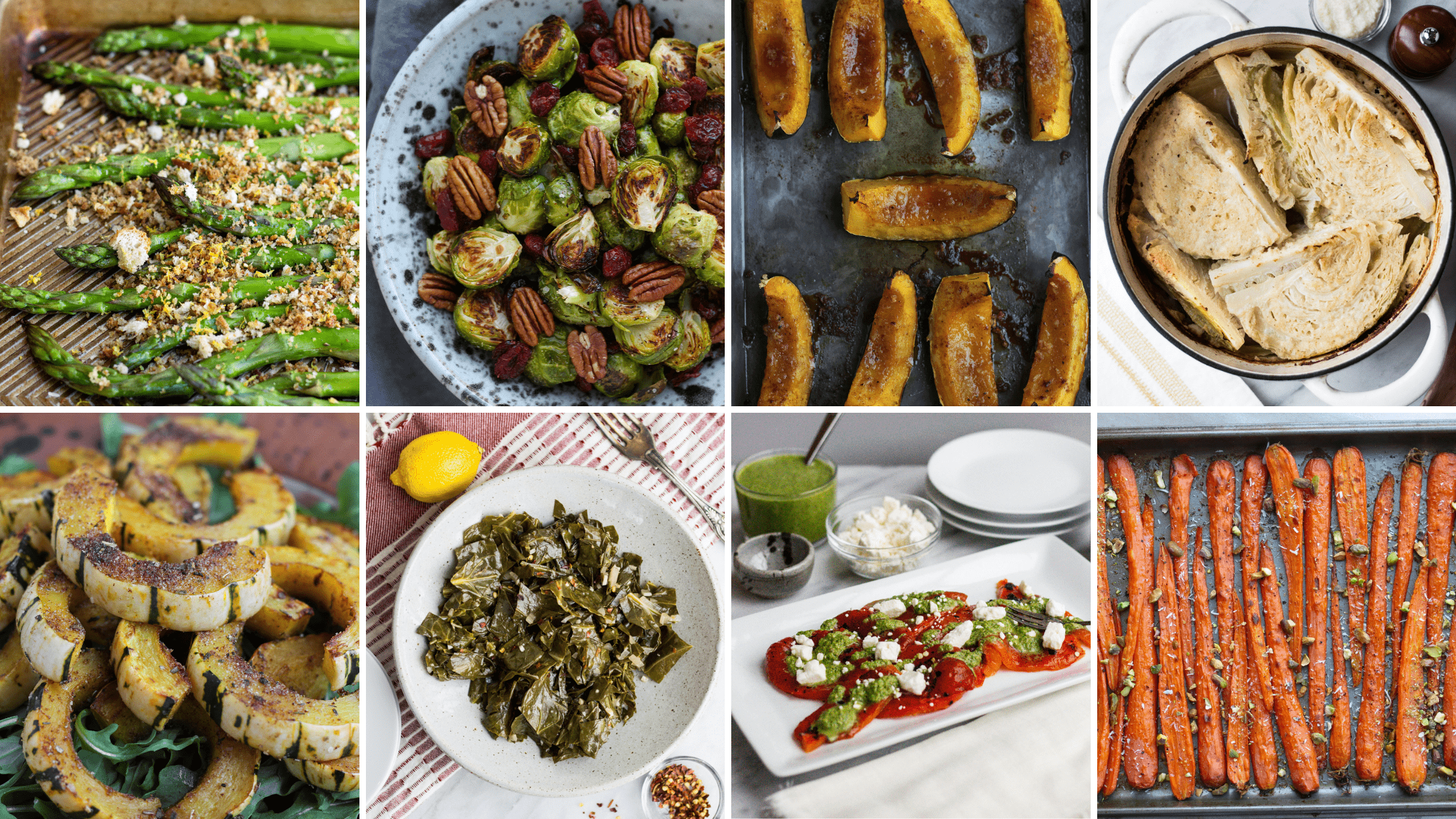A guide for how to roast and braise vegetables! Learn about these two versatile cooking methods and how long to cook popular vegetables.
Roasting Versus Braising
Roasting and braising: how familiar are you with these two cooking methods? Excellent options for both Winter and Spring vegetables, both roasting and braising yield tender and delicious results.
Not sure what the difference Is between roasting and braising? Wanting to experiment with new ways to prepare vegetables? Read on to learn more about these versatile cooking methods and find recipes to try them out.
Roasting Vegetables
When it comes to simple hands-off cooking methods, you can’t beat roasting. Prep, season, and toss in the oven: the heat will concentrate flavors and soften whatever you’re cooking.
Roasting is my favorite way to enjoy vegetables during the chillier winter months. Root vegetables are wonderful roasted and can handle the high heat and long cook times nicely.
Roasting is a familiar way that many already prepare vegetables. Technically, roasting is when you cook something in its original form in your oven. Low or high heat may be applied, and the result is deeper flavors and a tender bite. We’re focusing on vegetables this month as part of my So Happy In The Kitchen series, so let’s dive into specifically how to roast veg!
Though I offer some inspiration below for some recipes to consider as you begin to explore roasting, the beauty of this versatile method is that a recipe isn’t really necessary. Here are the basic steps to perfectly roast vegetables!
How To Roast Vegetables
- Preheat your oven. 400 degrees is a great place to start. The high heat allows for quick browning and crisping and softens your vegetables quickly. If you’re looking to slow roast something (and are ok without that classic crispy exterior), start with 300 degrees.
- Prep your veg. Check out my guide for How To Prep Vegetables Like A Pro for additional details on how to prep seasonal vegetables.
- Line a baking sheet. I like using unbleached parchment paper. This helps with preventing your vegetables from sticking to the baking sheet, and of course, allows for easier clean-up.
- Add fat. Check out this article all about the different types of fat you can use.
- Season, season, season! Don’t forget your seasoning. Revisit my guide to Spices which goes through the spices I like to cook with on a regular basis.
- Roast it up. The below offers some guidance for roasting times, but I always advise people to test as they go to determine which level of doneness they prefer. Personally, I like my broccoli a bit underdone, so take note of what you like and adjust the timing accordingly.
Here are a few recipes to encourage you to try roasting vegetables.
Recipes To Practice Roasting Vegetables
Braising Vegetables
Braising is another fantastic method that yields tender melty results. While similar to roasting, the addition of a cooking liquid is what sets braising apart. Food is placed in a cooking vessel with aromatics along with stock, water, wine, beer or some combination to be slowly cooked.
Braising in general is an amazing cooking method to familiarize yourself with. It’s great for winter vegetables like cabbage, squash, and hearty greens. Here’s how to braise that veg!
How To Braise Vegetables
- Pick your pan. Check out my article for Essential Cookware Every Kitchen Should Have for some of the pieces that grace my own kitchen. When braising, I opt for a cast iron Dutch oven pan with a tight-fitting lid.
- Add aromatics (if you like!). After adding your fat of choice, add optional aromatics based on the style of dish you’re preparing. Garlic is typically a non-negotiable in my household. Onions, shallots, carrot, and celery make other fantastic options, too.
- Add your veg. The goal is to keep as even of a level as possible, as you’ll be adding enough liquid to cover your ingredients about halfway.
- Time for liquid. As previously mentioned, you can opt for a variety of different liquids. Stock, wine, beer, and water are traditional options, but don’t let that restrict you. A splash of vermouth, red wine vinegar, or cider all make lovely additions and unique flavor profiles. Add enough to cover your ingredients halfway.
- Add to the oven, and forget about it! Kind of. Braising is one of those hero-cooking methods that doesn’t require much of you, but pays dividends in the flavorful end result. Cook until vegetables are fork-tender and smell amazing.
Recipes To Practice Braising Vegetables
How Long To Roast And Braise Vegetables
How you prepare your vegetables will dictate how long you should roast or braise them.
For example, the amount of time you would roast cubed sweet potatoes versus a whole sweet potato looks different. Cubed sweet potatoes are bite-sized, covered with oil and seasoning, and will take far less time to cook as opposed to a sweet potato that’s left whole.
Take this into consideration as you review the graphics below, offering guidance for how long to roast and braise common vegetables.


Find this collection for how to braise and roast vegetables helpful? Check out my “So Happy In The Kitchen” page, where I share helpful roundups of products, ingredient and cooking method education, and recipes tips and tricks!
You can also shop all of my favorites here.
Let’s be friends! Find me on Instagram, Facebook, and Pinterest!











One thought on “How To Roast and Braise Vegetables”